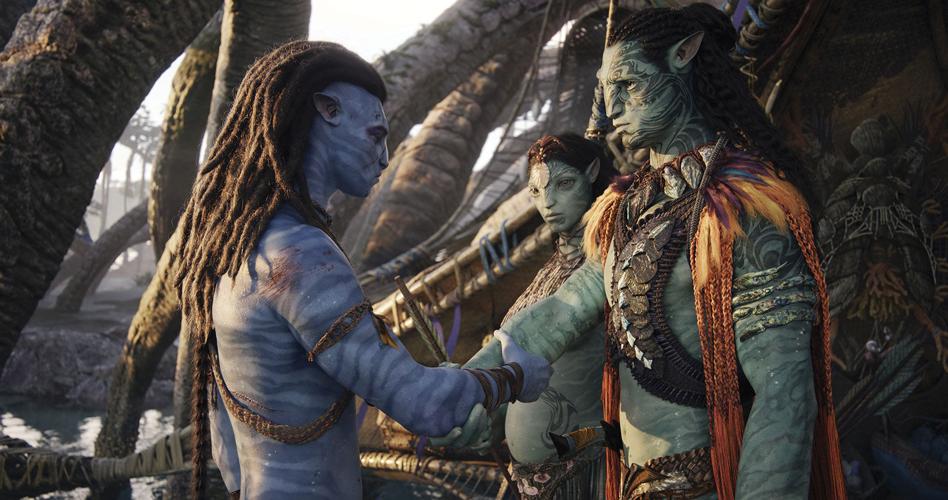I love 3D, and superseding all other feelings about Avatar: The Way of Water is the fact that I want this film to be successful enough that they start making 3D TVs again. There are too many fascinating and provocative works of 3D art for both means and message to simply be unavailable except on an extremely limited number of monitors whose ranks decrease just a little bit with every day that passes.
There are few people who love 3D more than director James Cameron, and it’s his passion for the form that in 2009 helped cement the digital changeover in mainstream exhibition with the first Avatar. It’s because of the promise of that film that so many of the theaters still in business during the neverending pandemic have at least one or two 3D-capable screens, though they’re rarely doing anything with them. Even the biggest Marvel and Disney releases will only devote one screen to the 3D incarnations of their latest releases, more often than not only for the first week and only one or two shows a day. This is due to Hollywood obstinately not paying attention to what Cameron told them the first time around about how to use 3D (don’t do shitty conversions, don’t gouge the customers, shepherd the form until it’s widespread and strong), and that is not a lesson lost on anyone who delights in the stereoscopic experience.
Cameron’s devotion to 3D (and his exceptional 3D conversions of Titanic and Terminator 2) is a tremendous plus in his favor, as are producing Strange Days and the Soderbergh Solaris and his peerless gift for narrative structure. These pluses are offset by some other choices; his insistence on digitally scrubbing the grain from his films shot on celluloid is continually troubling — the current HD master of Aliens, available on Blu-ray and currently screenable on DCP in theaters the world over, is unwatchable, a waxy nightmare that does grave disservice to one of the truly great action-horror films of all time. It stands to reason that a new film from him would in some way embody this complex proportion, and after viewing Avatar: The Way of Water in his preferred format (3D Dolby Vision, presented in a 48-frames-per-second high frame rate that uses doubled frames for non-action sequences), I’m once again processing the work from a director who is his own dialectical exercise.
High frame rate is one of those things that has been dabbled in here and there (namely, in recent films from Ang Lee and Peter Jackson), and there still hasn’t been a definitive explanation for what exactly it brings to the table — other than making the most special of digital effects seem “more real.” (That is, with the same kind of movement as objects and individuals who actually existed and were photographed rather than being rendered.) High frame rate does that thing The Matrix did, where it makes The Fake feel just as real as The Real while also making The Real feel as fake as The Fake. HFR is a whole thing that you eventually get used to while watching a film, and it can lead to some truly transcendent moments. (There’s a shootout in Lee’s 2019 film Gemini Man in which a fusillade of bullets becomes a living Giacometti sculpture, and it’s utterly breathtaking, and despite the many problems with the first Hobbit film, it allows Gollum to feel so tactile and real that it’s as if some form of magick or alchemy was involved.)

Avatar: The Way of Water
But the problem is that this hybrid approach to HFR means the brain is constantly being shocked back and forth between the two modes of experience. The ways we perceive traditional 24 fps cinema versus any of the higher frame rates (and here I’m specifically talking about 30 to 60 frames per second, because the really high frame rates, like Lee’s 120 fps Billy Lynn’s Long Halftime Walk, don’t even feel like movies, but rather live experiences being watched through the proscenium arch of “reality”) are two very different mental processes. Simply put, as enthralling as the visual pleasures of this film are, it’s impossible for my curmudgeonly old-man eyes to fully engage with what’s happening, because things keep alternating between two very different modes of seeing.
The Way of Water is a better film than its 2009 progenitor, mainly because it expands its focus and perspective. We’re still working in almost exclusively refined archetypes, but Cameron (and co-writers Amanda Silver and Rick Jaffa) are in sequel/dynasty mode, conscious of narrative and thematic shifts coming later on. The Marvel Cinematic Universe has a problem with this because it has to keep fitting everything it’s doing into this grand, overarching continuum, whereas Cameron et al. are growing their continuum organically from the seeds they have planted and tended. Short version: It’s like the Dune books.
In no way was I expecting that one of the pleasures of this film would be sullen teen Sigourney Weaver. As the adopted enigma Kiri, Weaver uses the motion-capture photography process to create something new — though she appears as her character Grace from the first film in both flashback and mycelial-apparition forms, it’s in this weird subversion of Hollywood’s current obsession with de-aging technology that she is able to make this new character live and breathe. And honestly, who hasn’t gone through their tumultuous teens and not felt like they were carrying Sigourney Weaver-sized drama while also getting seriously filled with rage at whalers?
Is it a problem that as a viewer I relate more to the technical side of things with this film? I enjoyed The Way of Water enough that I’m planning on seeing it again in 4DX (which apparently is not a high-frame-rate presentation, which intrigues me greatly. … I want that 3D majesty in a consistently 24 fps 3D presentation). That already elevates this sequel above its predecessor, which I saw once in an IMAX 3D setup that my addled brain recalls as being on actual 70 mm film, and then never felt the need to revisit. Perhaps the hybrid HFR presentation is a literal incarnation of time passing me by? But I’ll tell you, I could watch hours of the countless aquatic creatures lurking in the seas of Pandora. The giant, almost Acanti-like catfish whales around whom major third-act developments revolve. The jellyfish trees, carrying life throughout this wild world. The butterfly anemones that grant breath underwater, diaphanous wing-lungs just chilling in the current. The teeny-tiny squidminnows, glowing in the darkness, shining a way forward, a way through to something new.







